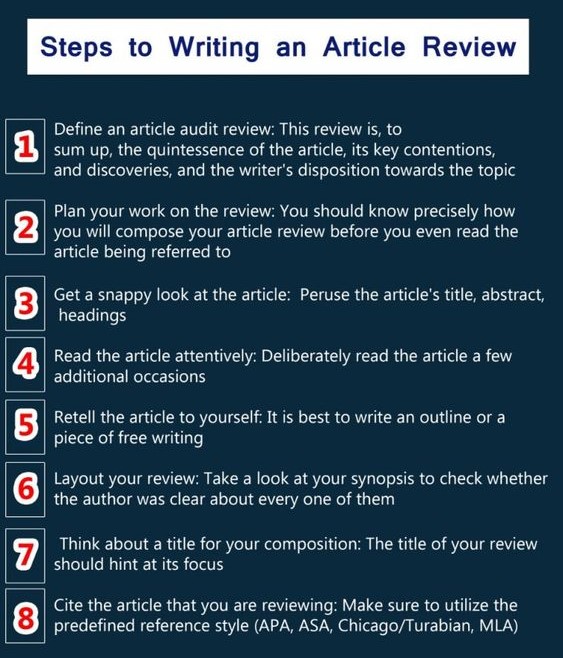
Table of Contents
Navigating the currents of knowledge and gaining valuable insights can be a daunting task in the vast and ever-expanding ocean of academic literature. Article reviews serve as the life rafts that guide us through the dense waters of research and help us understand the significance of individual studies. A well-crafted article review is not simply a summary but a critical analysis that evaluates the strengths and weaknesses of a piece of research, placing it within the broader context of the field.
The following guide will equip you with the skills and tools to write a powerful and insightful article review.
Understanding the Purpose and Components of an Article Review
Before diving into the writing process, it’s crucial to grasp the fundamental purpose and key elements of an article review. While article reviews can play various roles, you should aim at three main goals:
- Summarize the article’s main points: This includes outlining the research question, methodology, findings, and conclusions. You should think of it as a condensed version of the original paper, presented in a clear and concise manner.
- Analyze and critique the article: This is where your critical thinking skills should be put to the test. Evaluate the strengths and weaknesses of the research, considering its methodology, analysis, and overall contribution to the field. Some of the questions to consider include:
- Is the research question well-defined and significant?
- Is the methodology appropriate and rigorous?
- Are the findings supported by the data and adequately presented?
- Are the conclusions justified and relevant to the broader field?
- What are the limitations of the study?
- Place the article within the existing literature: How does this research fit into the broader conversation surrounding the topic? Does it build on existing knowledge, challenge existing theories, or offer new perspectives?
Step-by-Step Guide to Writing Your Review
Now that you have a firm understanding of the goals and components of an article review, let’s break down the writing process into manageable steps.

1. Careful Reading and Note-Taking
Begin by reading the article thoroughly, taking detailed notes as you go. Don’t just skim the surface but delve into the research design, methodology, data analysis, and key findings. Try to identify the central arguments and the evidence presented to support them. Here are some helpful note-taking strategies:
- Highlighting: Use different colors or symbols to mark important concepts, research questions, findings, and methodological details.
- Marginal notes: Jot down your initial reactions, questions, and critiques as you read.
- Summarizing each section: Condense the main ideas of each section in your own words.
- Creating a table or chart: This can help you organize the key elements of the study, such as the research question, hypothesis, variables, data analysis techniques, and major findings.
2. Identifying the Article’s Thesis and Research Question
What is the central argument or claim that the article makes? What specific question is the research trying to answer? Understanding the core purpose of the study will provide a framework for your review. Often, the thesis statement will be explicitly stated in the introduction or discussion sections.
3. Summarizing the Article’s Methodology and Findings
Your article review should provide a clear and concise summary of the research design, including the methods employed to collect and analyze data. This could include details about:
- Participants/Subjects: Who were the participants in the study? What were their characteristics?
- Data collection methods: How was the data collected (e.g., surveys, interviews, experiments)?
- Data analysis techniques: How was the data analyzed (e.g., statistical tests, qualitative coding)?
- Key findings: What were the main results of the study? Were the hypotheses supported or rejected?
4. Critically Analyzing the Article’s Strengths and Weaknesses
This is where you move beyond simply summarizing the article and give your own thoughtful evaluation. Consider the following questions:
- Methodology:
- Is the methodology appropriate for the research question?
- Are the data collection methods reliable and valid?
- Are there any potential biases in the study design or data collection?
- Are the data analysis techniques appropriate for the type of data collected?
- Findings:
- Are the findings clearly presented and supported by the data?
- Are the findings statistically significant?
- Do the findings answer the research question?
- Are the findings generalizable to other populations or settings?
- Contribution to the field:
- Does the study make a significant contribution to the field of knowledge?
- Does it challenge existing theories or offer new perspectives?
- Does it have practical implications for real-world applications?
5. Placing the Article Within the Broader Literature
How does this research fit into the existing body of knowledge on the topic? Does it support or contradict previous findings? Does it build upon existing theories or offer a new framework for understanding the issue? You can strengthen your review by:
- Mentioning relevant previous studies: Identify key studies that have addressed similar research questions or used similar methodologies.
- Highlighting areas of agreement and disagreement: Where does this research align with previous findings, and where does it diverge?
- Identifying potential future research directions: What questions remain unanswered? What are the next steps in this line of inquiry?
6. Writing the Review in a Clear and Concise Style
Your review should be written in a clear and concise style, avoiding jargon or overly technical language. Use transitions and topic sentences to guide the reader through your analysis. Here are some key writing tips:
- Use active voice: Active voice makes your writing more engaging and direct. For example, “The researchers found that…” is more direct than “It was found that…”
- Avoid plagiarism: Use quotation marks to indicate direct quotes, and cite your sources properly.
- Proofread carefully: Typos and grammatical errors can detract from the credibility of your review.
7. Structure and Organization
While the exact structure of your article review may vary depending on specific guidelines, a common framework includes:
Introduction:
- Briefly introduce the article and its topic.
- State the article’s main argument or research question.
- Briefly describe the author’s background and credentials.
Summary:
- Summarize the article’s methodology, findings, and conclusions.
- Be concise and focus on the key elements of the study.
Analysis and Critique:
- Evaluate the strengths and weaknesses of the research.
- Discuss the article’s methodological rigor, data analysis, and conclusions.
- Consider the limitations of the study.
Integration with Existing Literature:
- Discuss how the article fits into the broader field of knowledge.
- Compare and contrast the findings with previous research.
- Identify potential areas for future research.
Conclusion:
- Summarize your main points and provide a final evaluation of the article’s contribution to the field.
- Offer a concise and insightful closing statement.
Sample Article Review Structure
Here’s a sample outline to help you visualize the structure of your article review:
I. Introduction
* A. Article Title and Author(s)
* B. Briefly describe the article’s topic.
* C. State the article’s main argument or research question.
* D. Briefly mention the article’s publication context (journal, year).
II. Summary
* A. Briefly describe the article’s methodology.
* B. Summarize the article’s key findings.
* C. Summarize the article’s main conclusions.
III. Analysis and Critique
* A. Strengths of the research (methodology, findings, contribution).
* B. Weaknesses of the research (methodology, findings, limitations).
* C. Discuss any biases or limitations in the study.
IV. Integration with Existing Literature
* A. How does the article fit into the broader field of knowledge?
* B. Discuss any relevant studies that support or contradict the article’s findings.
* C. Identify any areas for future research.
V. Conclusion
* A. Summarize your main points and provide a final evaluation of the article’s contribution.
* B. Offer a concise and insightful closing statement.
Tips for Success
- Read the article multiple times: Thorough reading is crucial for understanding the nuances of the research.
- Take detailed notes: Use a system that works for you to capture key information, questions, and critiques.
- Consult your professor or advisor: Seek guidance on the specific expectations for your review.
- Proofread carefully: Ensure your review is free of grammatical errors, typos, and plagiarism.
Conclusion
Writing a good article review is a valuable skill that will benefit you throughout your academic journey and beyond. The strategies discussed above can guide you in crafting a comprehensive and insightful review that will enhance your understanding of the research, contribute to the academic discourse, and showcase your critical thinking abilities. Article reviews give you the opportunity to engage with different studies, question their findings, and contribute to the ongoing conversation in your field. However, it is not always an easy path and, having reliable academic writing help can make all the difference. At phdnursewriter, we offer professional and timely paper writing services, covering article reviews, essays, research papers and dissertations.





